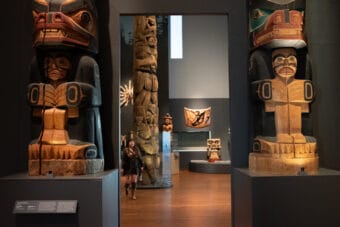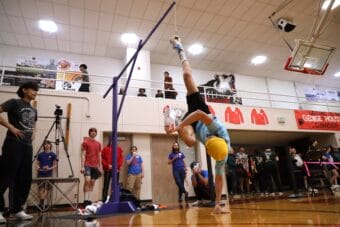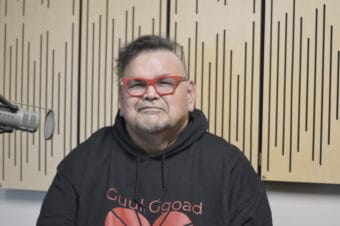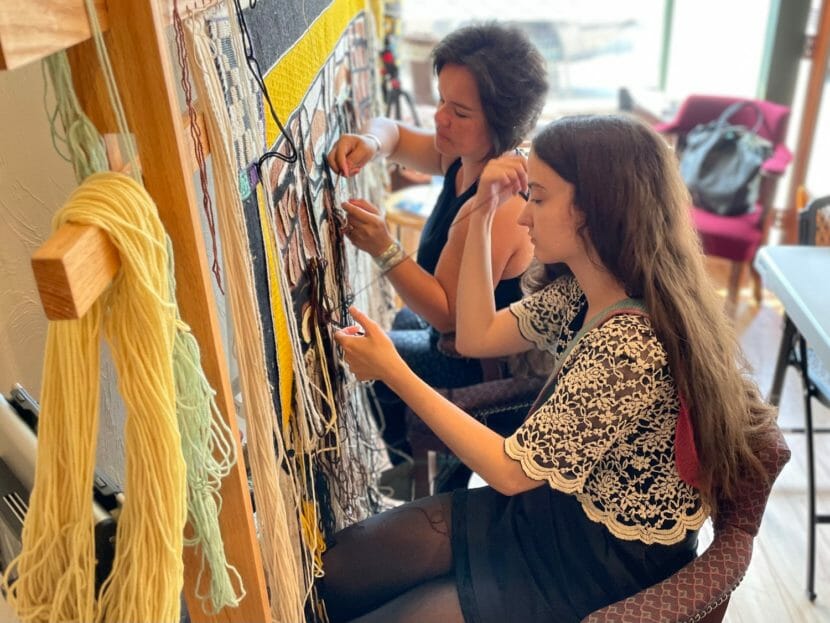
It’s called Between Worlds. And it features a diving whale.
“Peering through the bones of this diving whale pattern is this ancestor with her face and hands pressed against the veil between worlds,” Alaskan Chilkat and Ravenstail Weaver Lily Wooshkindein Da.Áat Hope said. “Because we talk about the Chilkat dancing blanket as the veil that separates our physical realm to the spirit realm on the other side.”
“So, this particular ancestor or teacher, or whomever, is in this space between worlds.”
Hope and weaving assistant Nadezdha Hughes are working on a full-size ceremonial Chilkat dancing blanket in Hope’s studio in Downtown Juneau. It’s for the Houston Museum of Natural Science and due in less than nine weeks. Chilkat weaving is one of the most complex weaving techniques in the world.
“We’ve got a cohort of people coming in to help. It’s totally fine,” Hope said. “My mother would say, ‘It’s going to be done because that’s the deadline it has to be done.’”
Hope’s mother, Clarissa Rizal, a renowned Chilkat and Ravenstail weaver who died in 2016, along with Hope and Hughes, are part of a teaching lineage that goes back hundreds of years. In a newly published book, historian Zachary Jones has traced that lineage to the 1850s when Clara Newman Benson, whose Lingít name was Deinḵul.át, was born.
“Clara Benson taught [Ester Johnson] to weave. [Johnson] taught her daughter Jenny Thlunaut to weave. Jenny Thlunaut taught Clarissa Rizal to weave. Clarissa Rizal taught a number of people to weave, including Lily Hope of Juneau, who is a weaver today and helping other weavers learn about this skill and art,” Jones said.
Researching ‘A Life Painted in Yarn’
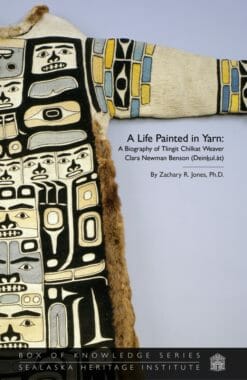
“A Life Painted in Yarn: A Biography of Tlingit Chilkat Weaver Clara Newman Benson” is the first-ever biography of the Klukwan artist who lived from 1856 to 1935 and was a significant Chilkat weaver of her day. Of the G̱aanax̱teidí clan, Yéil Hít (Raven House) of Klukwan, Benson was known for weaving Chilkat tunics and Chilkat robes.
Jones said she was one of the most prolific and sought-after weavers of the late 19th and early 20th centuries. He first heard about Benson when he was an archivist and collection manager for Sealaska Heritage Institute.
“I would acknowledge the late Johnny Marks. He was an elder and former coworker at Sealaska Heritage, and he would come to my office and bring a picture of her and say, ‘This is Mrs. Benson. She was a great weaver from our community,’” Jones said.
At that point, Jones didn’t even know her first name.
“He just said she was known as Mrs. Benson. And there were a few people who would say, ‘This is Mrs. Benson.’ There was not a lot of information known by anyone that I talked to or that could speak about her, so it really prompted me to try and address that. Who was this woman? What was her story?” Jones said.
Jones’ research into Benson’s life involved talking to individuals who had any information about her, including weavers and tribal historian Harold Jacobs who’s a cultural resource specialist at Central Council of the Tlingit and Haida Indian Tribes of Alaska. Jones researched hundreds of museum collections from all over the world, as well as historic records at archival and museum repositories that he could locate.
“I’ve reached out to every museum in the United States that holds ethnographic material in hopes of piecing together all the clues that I can,” Jones said.
He even found Benson’s own words.
“Clara Benson was interviewed by an anthropologist around 100 years ago, and she shared her words about Lingít history and provided some clues about her own life to him,” Jones said.
Jones hasn’t been able to locate any family or descendants of Benson. Still, he thinks his book offers “a window into her life and understanding of who she was.”
Jones said Benson was a leader in her community who served others.
“To be a weaver is not just to be an artist. It is to be a person who has immense patience and dedication to producing an item that takes many hours of labor,” he said. “That creation – though it’s an absolute, beautiful piece of art that takes many, many hours, sometimes six months to a year or more to create and gather the materials for – is something that’s important in the Lingít community. These robes are used ceremonially and have a very important role. And so Claire was not only just an artist, she’s someone that produced items that continue to live on and serve her community.”
The Shangukeidí (Thunderbird Clan) of Klukwan holds a robe that Benson weaved, according to Jones. People can still see it danced or worn at events in Juneau, like Celebration, or elsewhere in Southeast Alaska. As a leader of the Shangukeidí, the late Lingít elder and culture bearer Kingeistí David Katzeek used to wear it.
Benson is one of about two dozen historic Lingít individuals that Jones originally profiled in his dissertation, which he finished in 2018 for a doctorate in ethnohistory through the University of Alaska Fairbanks. “A Life Painted in Yarn” is published by Sealaska Heritage Institute.
There were limitations to Jones’ research, unanswered questions about Benson’s life he still can’t figure out. Like if Benson had any kids of her own.
“In the course of her life, she had three husbands that I’ve been able to document,” Jones said. “She had stepchildren through her second and third marriage, but I’ve never been able to document a biological child.”
Another unanswered question – who taught Benson to weave? Who precedes Benson in the teaching lineage?
“I could never determine that aspect,” Jones said. “It remains a mystery I’d like to solve someday.”
A whisper away
Back at Hope’s studio Wooshkindein Da.Áat, both Hope and weaving assistant Hughes said their teachers are with them as they weave.
“They are ever present. Like, Clarissa is forever present. She is always here, like a whisper away,” Hope said. “I definitely call on her and Jenny when I’m in the midst of chaos. I’m like, ‘Jenny, Clarissa, I don’t know what I’m doing.’ And, you know, they show up. They’ll pop in. If I can get out of my own head, my hands will move and do the thing they’re supposed to. I always give them credit because they know what I’m doing. I don’t know what I’m doing all the time.”
Hughes said she regularly practices gratitude to the entire lineage, including Benson, and those weavers whose names aren’t known.
“Like so many blankets you see, they’ll be like, ‘Oh, this artist was unknown.’ And it’s like, they were known, and they were probably very respected and very highly honored,” Hughes said. “So I always say thank you to everyone and all their weavings that we still have and even the ones we don’t have, and ask them to help me do justice to the work.”

